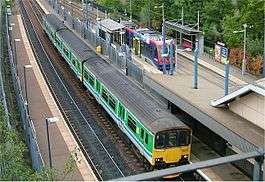Jewellery Quarter station
| Jewellery Quarter | |
|---|---|
|
Train and tram at Jewellery Quarter station | |
| Location | |
| Place | Jewellery Quarter |
| Local authority | Birmingham |
| Coordinates | 52°29′23″N 1°54′49″W / 52.4897°N 1.9136°WCoordinates: 52°29′23″N 1°54′49″W / 52.4897°N 1.9136°W |
| Grid reference | SP059879 |
| Operations | |
| Station code | JEQ |
| Managed by | London Midland |
| Number of platforms | 2 (train) + 2 (metro) |
| DfT category | E |
|
Live arrivals/departures, station information and onward connections from National Rail Enquiries | |
| Annual rail passenger usage* | |
| 2004/05 | 86,529 |
| 2005/06 |
|
| 2006/07 |
|
| 2007/08 |
|
| 2008/09 |
|
| 2009/10 |
|
| 2010/11 |
|
| 2011/12 |
|
| 2012/13 |
|
| 2013/14 |
|
| 2014/15 |
|
| Passenger Transport Executive | |
| PTE | Transport for West Midlands |
| Zone | 1 |
| History | |
| 1995 | Opened |
| National Rail – UK railway stations | |
| * Annual estimated passenger usage based on sales of tickets in stated financial year(s) which end or originate at Jewellery Quarter from Office of Rail and Road statistics. Methodology may vary year on year. | |
|
| |
| Midland Metro tram stop | |
|
Midland Metro platforms, looking towards Birmingham. | |
| Location |
Jewellery Quarter Birmingham England |
| Line(s) | Line 1 (Birmingham – Wolverhampton) |
| Platforms | 2 |
| History | |
| Opened | 31 May 1999 |
| Traffic | |
| Passengers (2013) | Approx. 900 daily[1] |
Jewellery Quarter station is a combined railway station and tram stop, situated in the Jewellery Quarter of Birmingham, England. The station is served by London Midland (who operate the station), Chiltern Railways, and the Midland Metro.
The station is set at the mouth of Hockley No 2 Tunnel below the elevation of its road-level access point on Vyse Street; stairs and a lift are provided.
History
The station was opened in 1995, as part of the "Jewellery Line" project which saw the re-introduction of cross-city services via Birmingham Snow Hill. Midland Metro services commenced in 1999, when its first (and so far only) line from Birmingham to Wolverhampton opened.
No previous station existed at this location, although it is a short distance from the previous Hockley station, opened by the Great Western Railway in 1854 and closed in 1972.
Facilities
The station has no car park, but ten cycle storage spaces are available.[2]
 The station frontage on Vyse Street, with to the right a grade II listed cast-iron urinal.
The station frontage on Vyse Street, with to the right a grade II listed cast-iron urinal. A Worcester-bound train on platform 1, far below street level which is on the level of the top floor of the building behind.
A Worcester-bound train on platform 1, far below street level which is on the level of the top floor of the building behind.
Services
Train
Most trains are operated by London Midland. The Monday to Saturday daytime service sees trains approximately every 10 minutes in each direction, operating between Stourbridge Junction, Birmingham Snow Hill, and either Dorridge or Whitlocks End. Many trains continue beyond Stourbridge to Kidderminster, Worcester Foregate Street or Great Malvern, and some continue beyond Whitlocks End & Dorridge to Stratford-upon-Avon.[3]
Chiltern Railways services operate in peak hours only, between Kidderminster and London Marylebone. Unlike London Midland services, only a few Chiltern trains call at Jewellery Quarter.
Metro
Midland Metro services operate at frequent intervals, between Birmingham and Wolverhampton St Georges. Mondays to Saturdays, services in each direction run at six to eight-minute intervals during the day, and at fifteen-minute intervals during the evenings and on Sundays.[4]
| Preceding station | Following station | |||
|---|---|---|---|---|
| Soho, Benson Road | Line 1 | St Paul's | ||
| |
||||
| Birmingham Snow Hill | London Midland Snow Hill-Worcester |
The Hawthorns | ||
| Birmingham Snow Hill | Chiltern Railways London-Kidderminster |
The Hawthorns | ||
See also
References
- ↑ "2013 West Midlands Travel Trends" (PDF). centro.org. Centro. Retrieved 9 September 2014.
- ↑ http://www.nationalrail.co.uk/stations/JEQ/details.html
- ↑ Table 71 National Rail timetable, May 2016
- ↑ "Midland Metro timetable". Network West Midlands. Retrieved 14 December 2015.
External links
| Wikimedia Commons has media related to Jewellery Quarter station. |
- Train times and station information for Jewellery Quarter station from National Rail
- Rail Around Birmingham and the West Midlands: Jewellery Quarter railway station

